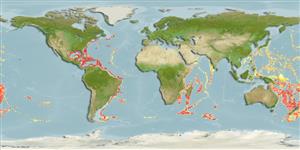>
Ophidiiformes (Cusk eels) >
Ophidiidae (Cusk-eels) > Neobythitinae
Etymology: Bassogigas: Latin, bassus = thick, fat + Latin, gigas, gigantis = giant (Ref. 45335).
More on authors: Goode & Bean.
Environment: milieu / climate zone / depth range / distribution range
Ecologia
marino batidemersale; distribuzione batimetrica 637 - 2239 m (Ref. 75877). Deep-water
Indo-West Pacific (between the southern tip of South Africa and New Caledonia) and Atlantic (except east Atlantic).
Size / Peso / Age
Maturity: Lm ? range ? - ? cm
Max length : 85.0 cm TL maschio/sesso non determinato; (Ref. 4103)
Short description
Morfologia | Morfometria
Spine dorsali (totale): 0; Raggi dorsali molli (totale): 103-110; Spine anali 0; Raggi anali molli: 82 - 88; Vertebre: 60 - 64. This species is distinguished and differs from B. walkeri by its long lateral line, snout to end of lateral line 64-80% SL (vs. 39.5% SL) and ending below dorsal fin ray number 47-69 (vs. 10) and above vertebra number 31-43 (vs. 12); scales in midline of body 130-150 (vs. 175); distance between base of pelvic fins and anal fin origin 24.0-32.5% SL (vs. 34.5% SL); two median basibranchial tooth patches, the anterior short and broad (vs. long and narrow); scale rows between origin of dorsal fin and lateral line 7-8 (vs. 11); sagitta thin, 12-16% its height (vs. 23% its length) (Ref. 86400).
Uncommon species (Ref. 34024). Oviparous, with oval pelagic eggs floating in a gelatinous mass (Ref. 205).
Life cycle and mating behavior
Maturità | Riproduzione | Deposizione | Uova | Fecundity | Larve
Nielsen, J.G. and P.R. Møller, 2011. Revision of the bathyal cusk-eels of the genus Bassogigas (Ophidiidae) with description of a new species from off Guam, west Pacific Ocean. J. Fish Biol. 78(3):783-795. (Ref. 86400)
IUCN Red List Status (Ref. 130435)
Threat to humans
Harmless
Human uses
Pesca: di nessun interesse
Informazioni ulteriori
Nomi ComuniSinonimiMetabolismoPredatoriEcotossicologiaRiproduzioneMaturitàDeposizioneSpawning aggregationFecundityUovaEgg development
Age/SizeAccrescimentoLength-weightLength-lengthLength-frequenciesMorfometriaMorfologiaLarveDinamica popolazioni larvaliReclutamentoAbbondanzaBRUVS
BibliografiaAcquacolturaProfilo di acquacolturaVarietàGeneticaElectrophoresesEreditarietàMalattieElaborazioneNutrientsMass conversion
CollaboratoriImmaginiStamps, Coins Misc.SuoniCiguateraVelocitàModalità di nuotoArea branchialeOtolithsCervelliVista
Strumenti
Special reports
Download XML
Fonti Internet
Estimates based on models
Preferred temperature (Ref.
123201): 2.5 - 7.4, mean 4.6 °C (based on 889 cells).
Phylogenetic diversity index (Ref.
82804): PD
50 = 0.7500 [Uniqueness, from 0.5 = low to 2.0 = high].
Bayesian length-weight: a=0.00110 (0.00041 - 0.00296), b=3.08 (2.85 - 3.31), in cm total length, based on LWR estimates for this (Sub)family-body shape (Ref.
93245).
Trophic level (Ref.
69278): 3.7 ±0.6 se; based on size and trophs of closest relatives
Resilienza (Ref.
120179): Basso, tempo minimo di raddoppiamento della popolazione 4.5 - 14 anni (Preliminary K or Fecundity.).
Fishing Vulnerability (Ref.
59153): Moderate to high vulnerability (54 of 100).
